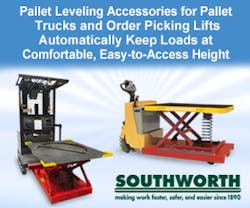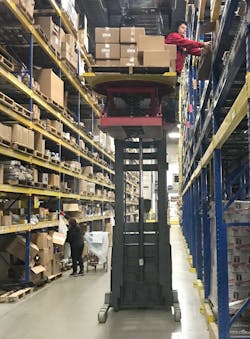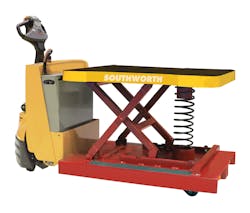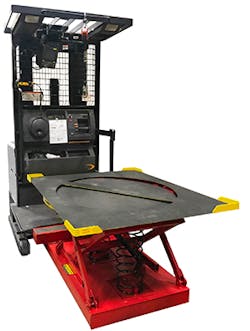Think about all the different types of beverages available today. Of course, diet and caffeine-free sodas have been on the market for years. But now consumers can find zero-calorie drinks made with stevia, drinks made with coconut water, more exotic flavors, and different size options. A single serving size can range from 7.5-ounce soda cans to 20-ounce water and sports drink bottles.
The food and beverage sector is just one example of an industry expanding its offerings to meet a diverse range of customer demands. This phenomenon, often referred to as SKU proliferation, has a significant impact on material handling operations. Pallets with different product mixes can wreak havoc on stocking and picking operations.
Filling large, single orders is much simpler. Material handlers can move entire pallet loads with forklifts directly to trucks. But short orders can be significantly more complex.
“Short orders are less than a pallet load, and on that pallet there could be many different SKUs,” says Jim Galante, director of business development at Southworth Products Corp, a maker of ergonomic material handling equipment. “Back at the warehouse, somebody has to go to these unique individual pick slots and pick up a case of this or a case of that.”
In addition, these warehouses can be massive, Galante says. It’s not uncommon for a worker to travel miles. In fact, on average, workers travel 8 miles to build orders over the course of a shift, according to Galante.
Another challenge today for warehouses and distribution centers is customer returns. In the modern world of e-commerce, customers can generate a return order with the click of a button. A large volume of returns can leave warehouses and stockrooms filled with a wide assortment of products. Workers often need to inspect the items before restocking them, Galante says.
“The result of meeting customer expectations is truckloads of merchandise coming back,” Galante says. “Returned goods have to be put back onto the shelf, so part of stock replenishment is filling shelves with returns.”
Avoid Costly ‘Solutions’
Manual picking and sorting through individual SKUs is inefficient and physically demanding, which can lead to injuries or high turnover rates. Forklifts are not practical solutions for short orders because workers must pull individual cases or boxes, Galante says. This means they may need to get on and off the forklift frequently to pull the cases and place them on a pallet or in a container.
“Forklifts can be used for order picking, but they are very expensive, and getting on and off the forklift, hooking up the seatbelt and releasing it, makes this a poor choice for an order picker,” Galante says.
Another possible solution is automation. Many larger organizations may use automation or even robots for order picking. But the leap to automation can be expensive for small and midsize organizations, and it brings its own set of problems, Galante says.
Some of the more cost-effective solutions to pick and place efficiently include high-rise order pickers and powered pallet jacks.
Taking a Step Up (Not Out)
High-rise order pickers (OP) or stock pickers are particularly useful in high bay warehouses where workers need to reach individual items to fill an order. Unlike typical lift trucks, the operator drives high-rise pickers from a standing position with the pallet positioned on a platform at a level angle with his or her feet, Galante says.
When the worker arrives at the pick bay, the lift raises the worker to the appropriate height – often 20 ft or higher. The operator picks the items and places them on the pallet that extends from the platform.
While high-rise pickers can increase efficiency, they come with some challenges that can be addressed with a simple accessory. When operators pick an item, they often need to step onto the pallet to reach it. Even with safety harnesses, stepping onto a pallet can be precarious. And, because the pallet is at their feet, workers repeatedly bend and reach to load items and create a uniform, stable load.
“Most of the physical stress a worker endures on an order picking lift can be eliminated if the pallet is in a more accessible position” says Galante.
Southworth’s PalletPal OP is a spring level loader that positions the pallet at waist level so workers can pick and place items without bending or reaching.
“We’ve been positioning pallets for workers at ground level for over 30 years with our spring level loaders,” Galante says. “The PalletPal OP adapts that technology for use with any high-rise order picking truck.”
The self-leveling unit attaches quickly without the need for tools, Galante says. As the pallet is loaded, the springs compress, keeping the top level of goods at an easily accessible height. An additional benefit to workers is the turntable top, which allows the pallet to be rotated so workers can load items from the safety of the operator platform instead of stepping out onto the pallet.
Powered-Up Pallet Jacks
Another popular option for order picking is the use of powered pallet jacks because they’re relatively inexpensive and highly maneuverable. Their versatility allows workers to access three sides of the pallet or container.
But like high-rise order or stock pickers, operators need an attachment to avoid bending or reaching when loading the pallets. The PalletPal Walkie also can attach to powered pallet jacks with similar ease to reduce or eliminate bending. In this scenario, as the worker stacks the boxes or containers, the Walkie platform compresses and a calibrated spring lowers the stack so the worker has convenient ergonomic access to the top layer of goods.
“Level loaders, like the PalletPal OP or Walkie, go a long way to reduce the stress of manual material handling in the order fulfillment,” Galante says. “The reduced stress equates to a significant reduction in fatigue and a corresponding increase in productivity.”
For more information, please contact Southworth Products Corp.
About the Author

Jonathan Katz
Freelance Editor and Writer
Jonathan Katz, owner of JSK Communications, is a freelance writer with more than 15 years of experience in the publishing industry. He is the former managing editor for Cannabis Business Times and Cannabis Dispensary at GIE Media and a former managing editor of IndustryWeek magazine at Endeavor Business Media.
At IW, Katz covered a wide range of manufacturing topics, including automation, safety, facilities/plant operations and executive leadership.
Prior to freelancing, Katz served as a project manager for Content4Demand, a content marketing agency.






